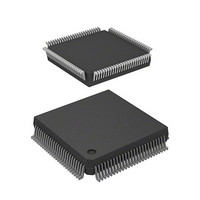HD6417034AFI20 Renesas Electronics America, HD6417034AFI20 Datasheet - Page 118

HD6417034AFI20
Manufacturer Part Number
HD6417034AFI20
Description
IC SUPERH MPU ROMLESS 112QFP
Manufacturer
Renesas Electronics America
Series
SuperH® SH7030r
Datasheet
1.HD6417034AFI20.pdf
(689 pages)
Specifications of HD6417034AFI20
Core Processor
SH-1
Core Size
32-Bit
Speed
20MHz
Connectivity
EBI/EMI, SCI
Peripherals
DMA, POR, PWM, WDT
Number Of I /o
32
Program Memory Type
ROMless
Ram Size
4K x 8
Voltage - Supply (vcc/vdd)
4.5 V ~ 5.5 V
Data Converters
A/D 8x10b
Oscillator Type
Internal
Operating Temperature
-20°C ~ 75°C
Package / Case
112-QFP
Lead Free Status / RoHS Status
Contains lead / RoHS non-compliant
Eeprom Size
-
Program Memory Size
-
Available stocks
Company
Part Number
Manufacturer
Quantity
Price
Company:
Part Number:
HD6417034AFI20
Manufacturer:
Renesas Electronics America
Quantity:
10 000
Company:
Part Number:
HD6417034AFI20V
Manufacturer:
Renesas Electronics America
Quantity:
10 000
- Current page: 118 of 689
- Download datasheet (5Mb)
Section 6 User Break Controller (UBC)
6.3
6.3.1
The flow from setting of break conditions to user break interrupt exception handling is described
below.
1. Break conditions are set in the break address register (BAR), break address mask register
2. The UBC checks to see if the set conditions are satisfied, using the system shown in figure 6.2.
3. On receiving the user break interrupt request, the interrupt controller checks its priority level.
4.
Rev. 7.00 Jan 31, 2006 page 90 of 658
REJ09B0272-0700
(BAMR), and break bus cycle register (BBR). Set the break address in BAR, the address bits
to be masked in BAMR and the type of break bus cycle in BBR. When even one of the BBR
groups (CPU cycle/DMA cycle select bits (CD1, CD0), instruction fetch/data access select bits
(ID1, ID0), read/write select bits (RW1, RW0)) is set to 00 (no user break interrupt), there will
be no user break even when all other conditions are consistent. To use a user break interrupt,
set conditions for all three pairs.
When the break conditions are satisfied, the UBC sends a user break interrupt request to the
interrupt controller.
The user break interrupt has priority level 15, so it is accepted only if the interrupt mask level
in bits I3–I0 in the status register (SR) is 14 or lower. When the I3–I0 bit level is 15, the user
break interrupt cannot be accepted, but is held pending until user break interrupt exception
handling is carried out. NMI exception handling sets I3–I0 to level 15, so a user break cannot
occur during the NMI handling routine unless the NMI handling routine itself begins by
reducing I3–I0 to level 14 or lower. Section 5, Interrupt Controller (INTC), describes the
handling of priority levels in greater detail.
INTC sends a request signal for a user break interrupt to the CPU. When the CPU receives it,
it starts user break interrupt exception handling. Section 5.4, Interrupt Operation, describes
interrupt exception handling in more detail.
Operation
Flow of User Break Operation
Related parts for HD6417034AFI20
Image
Part Number
Description
Manufacturer
Datasheet
Request
R

Part Number:
Description:
KIT STARTER FOR M16C/29
Manufacturer:
Renesas Electronics America
Datasheet:

Part Number:
Description:
KIT STARTER FOR R8C/2D
Manufacturer:
Renesas Electronics America
Datasheet:

Part Number:
Description:
R0K33062P STARTER KIT
Manufacturer:
Renesas Electronics America
Datasheet:

Part Number:
Description:
KIT STARTER FOR R8C/23 E8A
Manufacturer:
Renesas Electronics America
Datasheet:

Part Number:
Description:
KIT STARTER FOR R8C/25
Manufacturer:
Renesas Electronics America
Datasheet:

Part Number:
Description:
KIT STARTER H8S2456 SHARPE DSPLY
Manufacturer:
Renesas Electronics America
Datasheet:

Part Number:
Description:
KIT STARTER FOR R8C38C
Manufacturer:
Renesas Electronics America
Datasheet:

Part Number:
Description:
KIT STARTER FOR R8C35C
Manufacturer:
Renesas Electronics America
Datasheet:

Part Number:
Description:
KIT STARTER FOR R8CL3AC+LCD APPS
Manufacturer:
Renesas Electronics America
Datasheet:

Part Number:
Description:
KIT STARTER FOR RX610
Manufacturer:
Renesas Electronics America
Datasheet:

Part Number:
Description:
KIT STARTER FOR R32C/118
Manufacturer:
Renesas Electronics America
Datasheet:

Part Number:
Description:
KIT DEV RSK-R8C/26-29
Manufacturer:
Renesas Electronics America
Datasheet:

Part Number:
Description:
KIT STARTER FOR SH7124
Manufacturer:
Renesas Electronics America
Datasheet:

Part Number:
Description:
KIT STARTER FOR H8SX/1622
Manufacturer:
Renesas Electronics America
Datasheet:

Part Number:
Description:
KIT DEV FOR SH7203
Manufacturer:
Renesas Electronics America
Datasheet:











